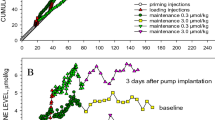Summary
The ability of the dopamine receptor antagonists haloperidol, raclopride and remoxipride to prevent the B-HT 920-induced decrease in striatal and limbic L-DOPA accumulation in gamma-butyrolactone (GBL)- and NSD 1015-treated rats (termed ‘GBL-reversal’) was used to define the effects of these compounds on “presynaptic” dopamine receptors. The doses of the dopamine antagonists producing antagonism of GBL-reversal were in each case roughly similar to the doses required to increase dopamine turnover in striatal and limbic areas. The potencies of haloperidol, raclopride and remoxipride in the GBL model were compared with their potencies in behavioural models for postsynaptic dopamine receptors. Haloperidol produced antagonism of GBL-reversal over a similar dose range to that required for antagonism of apomorphine-induced hyperactivity and stereotypy syndromes. Raclopride was effective in the order of potency: antagonism of apomorphine-induced hyperactivity > antagonism of GBL-reversal > antagonism of apomorphine-induced stereotypy. For remoxipride, the dose-response curve for antagonism of GBL-reversal was superimposable over that for antagonism of apomorphine-induced stereotypies, with an ED50 value about 12 times higher than that for antagonism of apomorphine-induced hyperactivity. Thus, the relative potencies of dopamine receptor antagonists at “pre-” and postsynaptic dopamine receptors vary considerably from compound to compound.
Similar content being viewed by others
References
Andén N-E (1980) Regulation of monoamine synthesis and utilization by receptors. In: Szekeres L (ed) Handbook of experimental pharmacology, vol 54/I. Springer, Berlin Heidelberg New York, pp 429–462
Andén N-E, Golembiowska-Nikitin K, Thornström U (1982) Selective stimulation of dopamine and noradrenaline autoreceptors by B-HT 920 and B-HT 933, respectively. Naunyn-Schmiedeberg's Arch Pharmacol 321:100–104
Bunney BS, Walters JR, Roth RH, Aghajanian GK (1973) Dopaminergic neurones: effect of antipsychotic drugs and amphetamine on single cell activity. J Pharmacol Exp Ther 185:560–571
Carlsson A (1975) Receptor-mediated control of dopamine metabolism. In: Usdin E, Bunney WE (eds) Pre- and postsynaptic receptors. Marcel Dekker, New York, pp 49–65
Carlsson A, Lindqvist M (1963) Effect of chlorpromazine or haloperidol on formation of 3-methoxytyramine and normetanephrine in mouse brain. Acta Pharmacol Toxicol (Copenh) 20:140–144
Chesselet M-F (1984) Presynaptic regulation of neurotransmitter release in the brain: facts and hypothesis. Neuroscience 12:347–375
Costall B, Naylor RJ (1973) The roles of telencephalic dopaminergic systems in the mediation of apomorphine-induced stereotyped behaviour. Eur J Pharmacol 24:8–24
DiChiara G, Porceddu ML, Spano PF, Gessa GL (1977) Haloperidol increases and apomorphine decreases striatal dopamine metabolism after destruction of striatal dopamine-sensitive adenylate cyclase by kainic acid. Brain Res 130:374–382
Fowler CJ, Thorell G, Andersson M, Magnusson O (1985) Is inhibition of striatal synaptosomal tyrosine hydroxylation by dopamine agonists a measure of dopamine autoreceptor function? Naunyn-Schmiedeberg's Arch Pharmacol 331:12–19
Hinzen D, Hornykiewicz O, Kobinger W, Pichler L, Pifl C, Schingnitz G (1986) The dopamine autoreceptor agonist B-HT 920 stimulates denervated postsynaptic brain dopamine receptors in rodent and primate models of Parkinson's disease: a novel approach to treatment. Eur J Pharmacol 131:75–86
Kirk RE (1968) Experimental design: Procedures for the behavioural sciences. Brooks/Cole, Belmont
Laschinski G, Kittner B, Bräutigam M (1984) Inhibition of striatal tyrosine hydroxylase by low concentrations of apomorphine. Naunyn-Schmiedeberg's Arch Pharmacol 327:114–118
Magnusson O, Fowler CJ, Köhler C, Ögren S-O (1986) Dopamine D2 receptors and dopamine metabolism. Relationship between biochemical and behavioural effects of substituted benzamide drugs. Neuropharmacology 25:187–197
Magnusson O, Mohringe B, Fowler CJ (1987a) Comparison of the effects of dopamine D1 and D2 receptor antagonists on rat striatal, limbic and nigral dopamine synthesis and utilisation. J Neural Transm 69:163–177
Magnusson O, Mohringe B, Thorell G, Lake-Bakaar DM (1987b) Effects of the dopamine D2 selective receptor antagonist remoxipride on dopamine turnover in the rat brain after acute and repeated administration. Pharmacol Toxicol 60:368–373
Martin GE, Williams M, Haubrich DR (1982) A pharmacological comparison of 6,7-dihydroxy-2-dimethylaminotetralin (TL-99) and N-n-propyl-3-(3-hydroxyphenyl)piperidine (3-PPP) with selected dopamine agonists. J Pharmacol Exp Ther 223:298–304
Ögren S-O, Hall H, Köhler C (1978) Studies on the stereoselective dopamine receptor blockade in the rat brain by rigid spiroamines. Life Sci 23:1769–1774
Ögren S-O, Hall H, Köhler C, Magnusson O, Lindbom L-O, Ängeby K, Florvall L (1984) Remoxipride, a new potential antipsychotic compound with selective anti-dopaminergic actions in the rat brain. Eur J Pharmacol 102:459–474
Ögren SO, Hall H, Köhler C, Magnusson O, Sjöstrand S-E (1986) The selective dopamine D2 receptor antagonist raclopride discriminates between dopamine-mediated motor functions. Psychopharmacology 90:287–294
Rollema H, Westerink BHC, Grol CJ (1976) Correlation between neuroleptic-induced suppression of stereotyped behaviour and HVA concentrations in rat brain. J Pharm Pharmacol 28: 321–323
Starke K, Späth L, Lang JD, Adelung C (1983) Further functional in vitro comparison of pre- and postsynaptic dopamine receptors in the rabbit caudate nucleus. Naunyn-Schmiedeberg's Arch Pharmacol 323:298–306
Walters JR, Roth RH (1976) Dopaminergic neurons: an in vivo system for measuring drug interactions with presynaptic receptors. Naunyn-Schmiedeberg's Arch Pharmacol 296:5–14
Westerink BHC (1979) The effects of drugs on dopamine biosynthesis and metabolism in the brain. In: Horn AS, Korf J, Westerink BHC (eds) The neurobiology of dopamine. Academic Press, London, pp 255–291
Author information
Authors and Affiliations
Additional information
Send offprint requests to O. Magnusson
Rights and permissions
About this article
Cite this article
Magnusson, O., Fowler, C.J., Mohringe, B. et al. Comparison of the effects of haloperidol, remoxipride and raclopride on “pre”- and postsynaptic dopamine receptors in the rat brain. Naunyn-Schmiedeberg's Arch Pharmacol 337, 379–384 (1988). https://doi.org/10.1007/BF00169527
Received:
Accepted:
Issue Date:
DOI: https://doi.org/10.1007/BF00169527




